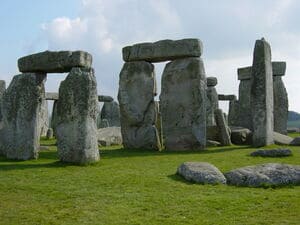StChill.com
Questions about Early Britain - Life in the UK Q&A
Life in the UK - Early Britain - Practice Test Questions - Chapter 3 Section 1
Question 1: When did the first farmers arrive in Britain?
Question 2: Who were the first people to live in Britain in what we call the Stone Age?
Question 3: In which English county is the monument of Stonehenge located?
Question 4: Which prehistoric village located in northern Europe has helped archaeologists to understand more about how people lived near the end of the Stone Age?
Question 5: What is the name of the best preserved prehistoric village in northern Europe and which origin traces back to the Stone Age?
Scroll down for the answers.
Question 6: When did people learn how to make bronze?
Question 7: What name is given to the tombs where people buried their dead during the Bronze Age?
Question 8: What characterised the Bronze Age?
Question 9: What characterised the people from the Bronze Age?
Question 10: What were the main occupations of the people during the Iron Age?
Scroll down for the answers.
Question 11: What was the most spoken language during the Iron Age?
Question 12: Which hill fort from the Iron Age can be seen in the county of Dorset?
Question 13: What was inscribed in the first coins to be minted in Britain during the Iron Age?
Question 14: Who was the first person to lead a Roman invasion in Britain in 55 BC?
Question 15: Who was Boudicca?
Scroll down for the answers.
Question 16: What was Boudicca, the queen of the Iceni in what is now eastern England, known for?
Question 17: Where can you find a statue of Boudicca, the queen of the Iceni and one of the tribal leaders who fought against the Romans?
Question 18: Which of the following civilisations is known for having built roads and public buildings, creating a structure of law and having introduced new plants and animals in Britain? The Norman,The Romans,The Vikings.
Question 19: When did the Roman army leave Britain?
Question 20: When did the Vikings first visit Britain to raid coastal towns and take away goods and slaves?
Scroll down for the answers.
Question 21: Which of the following words comes from the Viking language? Grimsby,Chelsea,Dundee,Scunthorpe.
Question 22: Who was the first Archbishop of Canterbury?
Question 23: Which TWO of the following forts form part of Hadrian’s Wall? Garland,Vindolanda,Housesteads,Bridger.
Question 24: Where in England was one of the Anglo-Saxon kings buried with treasure and armour?
Question 25: The Battle of Hastings is commemorated in a great piece of embroidery, which is known as:
Scroll down for the answers.

Question 1: When did the first farmers arrive in Britain?
Answer: 6,000 years ago. The first farmers arrived in Britain 6,000 years ago.
Question 2: Who were the first people to live in Britain in what we call the Stone Age?
Answer: Hunter-gatherers. The first people to live in Britain were hunter-gatherers, in what we call the Stone Age.
Question 3: In which English county is the monument of Stonehenge located?
Answer: Wiltshire.
Question 4: Which prehistoric village located in northern Europe has helped archaeologists to understand more about how people lived near the end of the Stone Age?
Answer: Skara Brae. Skara Brae on Orkney, off the north coast of Scotland, is the best preserved prehistoric village in northern Europe, and has helped archaeologists to understand more about how people lived near the end of the Stone Age.
Question 5: What is the name of the best preserved prehistoric village in northern Europe and which origin traces back to the Stone Age?
Answer: Skara Brae. Skara Brae on Orkney, off the north coast of Scotland, is the best preserved prehistoric village in northern Europe, and has helped archaeologists to understand more about how people lived near the end of the Stone Age.
Question 6: When did people learn how to make bronze?
Answer: Around 4,000 years ago. Around 4,000 years ago, people learned to make bronze. We call this period the Bronze Age.
Question 7: What name is given to the tombs where people buried their dead during the Bronze Age?
Answer: Round barrows.
Question 8: What characterised the Bronze Age?
Answer: People lived in roundhouses and buried their dead in tombs.
Question 9: What characterised the people from the Bronze Age?
Answer: They were accomplished metalworkers. The people of the Bronze Age were accomplished metalworkers who made many beautiful objects in bronze and gold, including tools, ornaments and weapons.
Question 10: What were the main occupations of the people during the Iron Age?
Answer: Farmers, craft workers or warriors.
Question 11: What was the most spoken language during the Iron Age?
Answer: Celtic. The language spoken during the Iron Age was part of the Celtic language family.
Question 12: Which hill fort from the Iron Age can be seen in the county of Dorset?
Answer: Maiden Castle. A very impressive hill fort from the Iron Age can still be seen today at Maiden Castle, in the English county of Dorset.
Question 13: What was inscribed in the first coins to be minted in Britain during the Iron Age?
Answer: The names of Iron Age Kings.
Question 14: Who was the first person to lead a Roman invasion in Britain in 55 BC?
Answer: Julius Caesar.
Question 15: Who was Boudicca?
Answer: One of the tribal leaders who fought against the Romans. One of the tribal leaders who fought against the Romans was Boudicca, the queen of the Iceni in what is now eastern England.
Question 16: What was Boudicca, the queen of the Iceni in what is now eastern England, known for?
Answer: Her rebellion against the Romans. One of the tribal leaders who fought against the Romans was Boudicca, the queen of the Iceni in what is now eastern England.
Question 17: Where can you find a statue of Boudicca, the queen of the Iceni and one of the tribal leaders who fought against the Romans?
Answer: At Westminster Bridge. There is a statue of Boudicca, the queen of the Iceni, on Westminster Bridge in London, near the Houses of Parliament.
Question 18: Which of the following civilisations is known for having built roads and public buildings, creating a structure of law and having introduced new plants and animals in Britain?
Answer: The Romans. The Romans remained in Britain for 400 years. They built roads and public buildings, created a structure of law, and introduced new plants and animals.
Question 19: When did the Roman army leave Britain?
Answer: AD 410.
Question 20: When did the Vikings first visit Britain to raid coastal towns and take away goods and slaves?
Answer: AD 789. The Vikings came from Denmark and Norway. They first visited Britain in AD 789 to raid coastal towns and take away goods and slaves.
Question 21: Which of the following words comes from the Viking language?
Answer: Grimsby and Scunthorpe. Words such as Grimsby and Scunthorpe come from the Viking languages.
Question 22: Who was the first Archbishop of Canterbury?
Answer: St Augustine.
Question 23: Which TWO of the following forts form part of Hadrian’s Wall?
Answer: Vindolanda and Housesteads.
Question 24: Where in England was one of the Anglo-Saxon kings buried with treasure and armour?
Answer: Sutton Hoo, Suffolk. The burial place of one of the Anglo-Saxon kings was at Sutton Hoo in modern Suffolk.
Question 25: The Battle of Hastings is commemorated in a great piece of embroidery, which is known as:
Answer: The Bayeux tapestry. The Battle of Hastings is commemorated in a great piece of embroidery, known as the Bayeux tapestry, which can still be seen in France today.
StChill.com
Contact us






